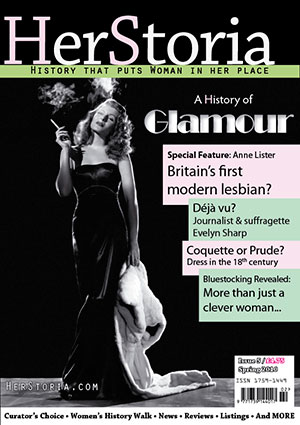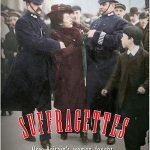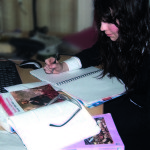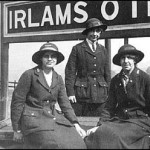Sylvia Pankhurst: Activist with Attitude - part 2
(…continued from part 1) After the passing of the 1913 Prisoners’ Temporary Discharge Act for Ill Health (known as the ‘Cat and Mouse’ Act) Sylvia was more than once released for short periods, only to be rearrested once sufficiently recovered. During these interludes she was often carried on a stretcher by supporters to attend meetings in London’s East End. Despite this, tension with her mother and sister escalated, due in part to Sylvia’s unease with the way that WSPU militancy was not following any controlled strategy or bringing working women into the fold. In the end, the ELF and WSPU broke all ties. Sylvia held strong pacifist views and when, on the outbreak of world war one, Emmeline and Christabel proved ardent war supporters, her estrangement from her mother and sister became entrenched.
Typically, Sylvia saw her role more clearly now. Men were disappearing to fight; women needed support. She opened a milk distribution centre and within three weeks had also launched a cut- price restaurant which served around four hundred meals a day. Soon after she founded a toy factory which provided jobs for women and persuaded West End stores to stock their products. Then, in April 1915, she opened a nursery and clinic in a converted pub which she named The Mothers’ Arms. Totally inexperienced in childbirth, she found herself acting as midwife to a terrified mother whose husband was away at the Front; she was there too to comfort a Jewish couple whose seventeen year old son had been shot for desertion. Believing that the war was an imperialist adventure, Sylvia also worked to oppose conscription and campaigned for peace on the pages of her newspaper, The Women’s Dreadnought.
After the 1917 Russian Revolution Sylvia saw Communism as the best way forward to achieve her ideals. She changed the name of her newspaper to The Workers’ Dreadnought and the name of her political organisation to The Workers’ Socialist Federation (she had already changed its name from the ELF to The Workers’ Suffrage Federation the previous year ). Among her new co-workers was Silvio Corio, an Italian journalist and revolutionary five years her senior. Corio was to remain at her side, professionally and personally, for thirty years.
In December 1917 the Representation of the People Act gave limited franchise to women over the age of thirty; it was a step forward but nowhere near Sylvia’s goal.
She began fighting for her new cause, for a Soviet-style form of government which she believed to be the most democratic. In 1919 Sylvia set off to speak at a conference of the Italian Socialist Party in Bologna, returning on foot alone, over the Alps via Germany. Back in England she worked with other revolutionary socialists on initiatives which led to the formation of the British Communist Party. Typically however, she could not always ‘toe the line’ and was expelled in 1921. Then began a robust correspondence with Lenin and, in July 1920, Sylvia crossed the North Sea and boarded a battered fishing boat to hitch a lift from Norway to Russia. In Moscow, comrades at the Second Congress of the Third International found her some straw to sleep on and lent her their bedding. Despite fears that they would clash, Lenin treated her with respect, took her to the opera and arranged for visits to various factories and co-operatives. She returned to England ready to create a brave new world and employed the first black journalist in Britain – American, Claude McKay.
But time was passing. Even in London’s East End, people were tired after the war. It was the age of flappers, skirts were short, shoes were flat and there was an air of gaiety. No one wanted to listen to Sylvia any more. It was time to move on. That move, made with Corio in 1924, was to a tiny ramshackle, rat-infested cottage—renamed Red Cottage—on Woodford Green, at the edge of Epping Forest. This turned out to be a period of chaotic creativity for Sylvia. In 1926 she published a six hundred-page book, India and the Earthly Paradise, and soon after, at the age of forty-five, became pregnant. In December 1927 Richard Keir Pethick Pankhurst was born. Sylvia did not marry Corio as this would have been to compromise her principles and belief in sexual freedom for men and women.
Despite the birth of a grandson, Emmeline and Sylvia were not reconciled. On March 29 1928, despite failing health, Emmeline was present in the House of Commons to witness the final debate on equal franchise for women. In May The Franchise Bill for which she had devoted her life was passed. It became known as ‘the flapper vote’ and enabled women to vote on equal terms with men. Emmeline died later that year and Sylvia attended her funeral with her young son in his pram.
The arrival of Richard Keir Pethick Pankhurst necessitated a move for Corio and Sylvia to the large Edwardian house, West Dene, in pleasantly suburban Charteris Road, from which the ‘scarlet woman’ ran her increasingly passionate campaigns.
Sylvia was a capable and loving mother – and fortunate that Corio took over the cooking and shopping at which she was so totally inept. Much of her attention turned now to the care and upbringing of children. Young Richard grew up amid secure chaos, surrounded by books and colourful personalities such as Jomo Kenyatta who came to visit on the train. Richard remembers coming down in the mornings to find his mother still working, after a whole night at her typewriter, producing books, articles and letters which flooded from her in the usual torrent. It was around this time that Sylvia began writing about her new disillusion with the Bolshevik movement; she turned her back on Russia and looked towards Ethiopia (Abyssinia).
Ethiopian independence became a central focus of Sylvia’s activities for the remainder of her life. When Italian fascists invaded Ethiopia in 1935-6, Sylvia embarked on a correspondence in the press demanding that Winston Churchill urge sanctions on Italy. Two secretaries were now working for her flat out, and a team of volunteer helpers. Sylvia organised rallies and marches and started another campaigning newspaper, New Times and Ethiopia News, which she edited for some twenty years. Eventually Churchill spoke out in agreement – he and Sylvia were at last of one mind. In her campaign against fascism Sylvia launched an onslaught on anyone, anywhere, with influence. She drove embassies, politicians, editors, to distraction with her barrage of letters, often in green ink, on paper torn from exercise books. When, in 1936, the exiled Emperor arrived at Victoria Station, Sylvia was there, alone, to welcome him. During his stay in Bath they became good friends.
By the outbreak of world war two Sylvia had become a national institution. The Foreign Office had a file on ‘how to deal with letters from Miss Pankhurst’ and Hitler added her to his list of those to be arrested on his threatened invasion of England. In 1942, Haile Selassie returned home triumphant but suffered personal tragedy with the death of his newly-married daughter, the Princess Tsahai. Sylvia and she had become friends when Tsahai was a nurse at Guy’s Hospital in London and it was Sylvia, of course, who launched a fundraising campaign to build a new hospital in her memory in Addis Ababa. It took ten years to raise the £100,000 target, helped by a donation from Queen Elizabeth, wife of King George V. The Emperor never forgot and Sylvia was guest of honour at the hospital opening in 1951.
Corio died in 1954 and Richard remembers how his mother wept for days. With her partner gone she returned to writing another gargantuan six hundred-page book, Ethiopia: A Cultural History. At this time Sylvia re-established contacts with people who had worked with her during the earlier suffrage campaign, including Teresa Billington-Greig, one of the founder members of the WSPU. She also corresponded again with her sister Christabel (she had never lost contact with her younger sister Adela who shared her socialist views). But in 1956 she decided that the time was right to accept the Emperor’s invitation to leave England and live in his country. Richard had by then completed a Doctorate at the London School of Economics and was ready to take a post at Addis Ababa University with Rita, his wife-to-be.
Sylvia closed her newspaper and left West Dene for Heathrow, with her Persian cat in a basket, her paints and the inevitable brown paper parcel bursting under her arm. Woodford hardly noticed her going. In Addis Ababa, it was not long before she and her ramshackle old Fiat bumping around the countryside became a national institution there too. She travelled into remote and sometimes dangerous regions, working in particular for better conditions for women and babies. But on 27 September 1960, while Rita and Richard were away on a camping trip, Sylvia suffered a coronary thrombosis and died in the bungalow she had come to love so much. By her side were her scribbled notebooks and the usual pile of papers; above the bed was the framed text of her father’s 1885 election address. She was seventy-eight. The Emperor ordered that Sylvia be given a state funeral which he himself attended along with other members of the royal family. The Ethiopian Church did not recognise the name ‘Sylvia’ so they gave her a new one. Ironically, atheist Sylvia was buried in Addis Ababa’s Christian cemetery with the words ‘Walata Cristos’ (Daughter of Christ) inscribed on the tomb.
Tucked away in the Pankhurst archives, now housed in Amsterdam, is a handwritten message:
How I would like to be remembered.
Let me be counted among the citizens of the world who own no barriers of race or nation, whose hopes are set on the golden age of universal fraternity we believe to come.
But what is Sylvia remembered for today? Mostly for her suffrage campaigning and for her published histories of the movement which have been used as a source for later accounts, in particular The Suffragette (1911) and The Suffragette Movement (1931). However she has not been given a central place in histories of socialist and revolutionary politics; nor in histories of feminist agitation beyond suffrage. Sylvia was passionately independent and could be arrogant and disdainful of compromise. Her frequent ‘fallings out’ with co-campaigners could also leave her isolated, rendering her less interesting to historians chronicling movements rather than individuals. It has been said that Sylvia ‘lacked the glamour’ of Emmeline and Christabel, who tended to use their femininity knowingly as a way to reassure as to the ‘womanliness’ of female campaigners for the vote. In contrast, Sylvia wore unstylish clothes and no cosmetics as she believed that lipstick ‘reveals the slave mentality’. Nonetheless, Sylvia was a charismatic campaigner for political, personal and sexual freedoms and a woman whose thinking was ahead of its time. What would be the issues to provoke her passion were she alive today?
Need to Know…
Shirley Harrison is the author of Sylvia Pankhurst: Citizen of the World (Hornbeam, 2009)![]() and Sylvia Pankhurst: A Classroom Companion
and Sylvia Pankhurst: A Classroom Companion![]() , edited by Talvinder Bhuller (Hornbeam 2009). She is the first biographer of Sylvia Pankhurst to have had the full co-operation of the Pankhurst family, as well as access to a number of previously unpublished documents.
, edited by Talvinder Bhuller (Hornbeam 2009). She is the first biographer of Sylvia Pankhurst to have had the full co-operation of the Pankhurst family, as well as access to a number of previously unpublished documents.
See also - Shirley Harrison, Sylvia Pankhurst, a Crusading Life 1882-1960 (Aurum, 2003; reprinted as Sylvia Pankhurst: A Maverick Life 1882-1960![]() )
)
Other sources:
- June Hannam, ‘Pankhurst, (Estelle) Sylvia’, Oxford Dictionary of National Biography
- Melanie Phillips, The Ascent of Woman: A History of the suffragette movement and the ideas behind it (Abacus, 2004)

Featured image: Sylvia Pankhurst at a suffrage protest in Trafalgar Square (1912)
Time & Life Pictures/Getty Images












Leave a Reply